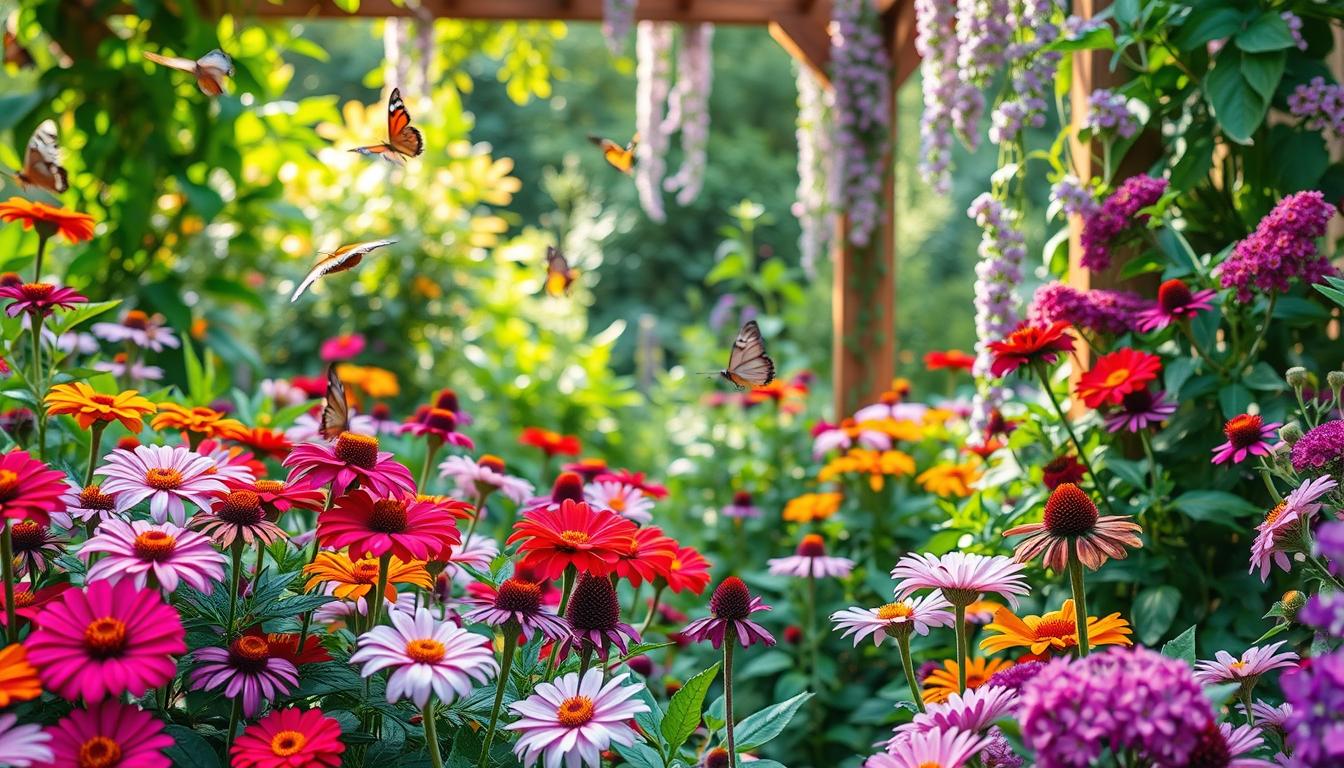
Creating a Butterfly-Friendly Garden: Attract Beauty to Your Patio
Are you tired of having a dull patio? Imagine transforming it into a vibrant oasis that attracts beautiful creatures and brings joy to your outdoor space.
Can you envision sipping your morning coffee surrounded by the gentle flutter of butterflies as they flit from flower to flower? Creating a butterfly-friendly garden is easier than you think. It’s a great way to add some excitement to your outdoor living area.
By incorporating the right plants and design elements, you can create a haven that not only attracts these beautiful creatures but also supports their well-being. In this article, we’ll guide you through the process of designing and maintaining a garden that will become a haven for these lovely visitors.
Why Butterflies Are Essential to Your Garden
Butterflies are key to a healthy garden. They help pollinate plants and show if the environment is balanced. Their presence means your garden is diverse and thriving.
Butterflies are vital for your garden’s health and variety. Knowing their importance helps you make your garden a better place for them.
The Role of Butterflies in Ecosystems
Butterflies are important pollinators, just like bees. They move pollen between flowers, helping plants reproduce. They also tell us about the environment’s health. Changes in their numbers can warn of bigger issues like habitat loss or climate change.
The variety of butterflies in your garden shows the health of your local ecosystem. Supporting their conservation helps keep biodiversity alive.
Benefits of Attracting Butterflies
Having butterflies in your garden is great. They add beauty and help local wildlife. They love gardens with lots of flowers and plants for their young.
Creating a garden for butterflies helps them and supports their survival. It’s rewarding to see different species visit your garden.
Butterflies also make your garden look better. They make it a lovely place to relax and enjoy.
Choosing the Right Location for Your Garden
The success of your butterfly garden depends on the right location. A good spot can help butterflies thrive.
Sunlight Requirements for Butterflies
Butterflies need sunlight to warm up. It’s important to pick a spot that gets ample sunlight. They need at least 6 hours of direct sunlight a day to fly and be active.
Proximity to Water Sources
Butterflies also need water to survive. They drink it and use it to keep their body temperature right. Having a water source nearby, like a pond or a birdbath with fresh water, attracts more butterflies to your garden.
Selecting Butterfly-Friendly Plants
The right plants can make your garden a butterfly paradise. They provide what butterflies need to thrive. Choosing the right plants is key in butterfly gardening and affects the butterfly life cycle.
To welcome butterflies, you need to know which plants attract them. It’s important to pick plants that support their life stages.
Native Plants That Attract Butterflies
Native plants are essential for a butterfly-friendly garden. They have evolved with local butterflies, offering the right food and shelter. For example, Milkweed is great for Monarchs, and Butterfly Bush attracts many species.
Flowers with Nectar and Pollen
Butterflies love flowers with lots of nectar and pollen. These flowers give them energy. Lantana, Zinnia, and Marigold are perfect because they’re full of nectar and easy to grow.
Host Plants for Caterpillars
For the butterfly life cycle, host plants for caterpillars are crucial. These plants feed caterpillars as they grow. For instance, Dill and Parsley are good for Black Swallowtail caterpillars.
By mixing native plants, nectar-rich flowers, and host plants, you can make a garden that supports butterflies. This diversity helps them through their entire life cycle.
Creating a Diverse Planting Scheme
Creating a garden with many different plants attracts more butterflies. This variety is not just for looks. It also makes your garden welcoming to various butterfly species.
By mixing plants, you meet the needs of these beautiful creatures. This makes your garden a perfect home for them.
Importance of Plant Variety
A diverse garden is a haven for butterflies. Different species like different things. Some like flowers with lots of nectar, while others need specific plants for their young.
Plant variety keeps butterflies coming back all season. With plants that bloom at different times, you offer food and shelter constantly.
| Plant Type | Butterfly Attraction | Seasonal Bloom |
|---|---|---|
| Nectar-rich Flowers | Attracts adult butterflies | Spring, Summer |
| Host Plants | Supports caterpillar development | Varies by species |
| Shrubs and Trees | Provides shelter and perching sites | Year-round |
Seasonal Blooms for Continuous Attraction
To keep your garden interesting all season, include plants that bloom at different times. This way, you always have nectar and pollen for butterfly migration.
Early spring bloomers like azaleas and lilacs welcome butterflies back. Summer bloomers like butterfly bushes and zinnias feed them during their busy months. In fall, asters and sedum help fuel their journey to winter.
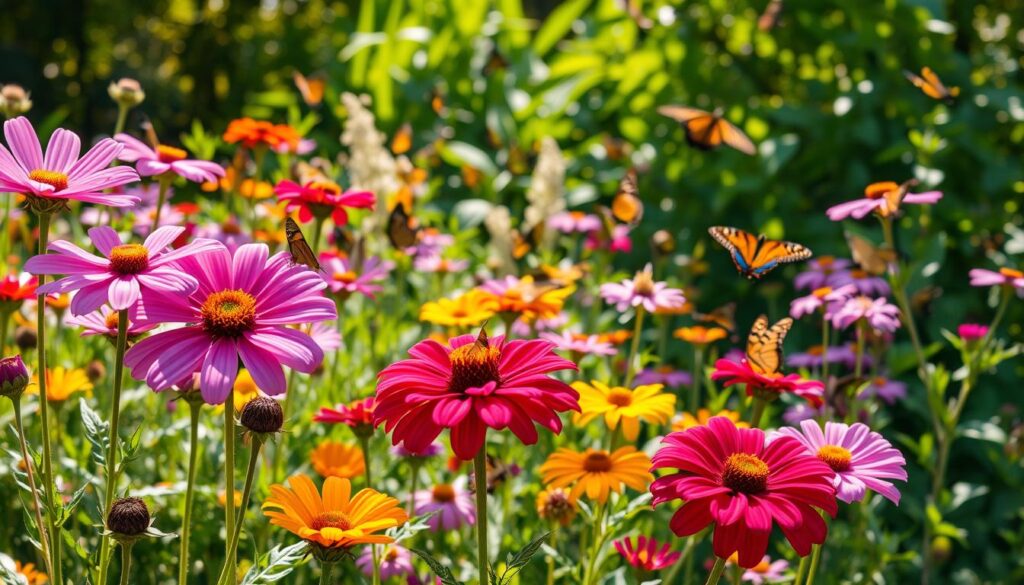
Designing Your Garden Layout
A well-designed garden layout is key for a butterfly-friendly space. By thinking about what butterflies need, you can make a beautiful and useful area.
Butterfly Garden Size Considerations
The size of your garden matters a lot for attracting butterflies. A bigger garden can have more plants, drawing in more butterfly types. But, a small garden can also work well if it has the right butterfly-friendly plants.
Think about your garden’s size and how to use it best. This will make it welcoming for butterflies.
Zones for Feeding and Resting
Butterflies need places for eating and resting. Make zones in your garden for these needs. For example, have areas with lots of flowers for food, and spots for resting.
Designing your garden with these zones helps. It makes your garden more inviting for butterflies. This boosts your butterfly gardening and chances of attracting butterflies.
Providing Essential Resources
A butterfly-friendly garden is more than just flowers. It’s about giving them what they need to survive. This includes water, shelter, and shade.
Adding a Water Source
Butterflies drink water and use it to keep their body temperature right. A shallow dish or birdbath with fresh water and rocks or twigs is great. Make sure to change the water often to keep it clean and mosquito-free. This simple step can make your garden a better butterfly habitat.
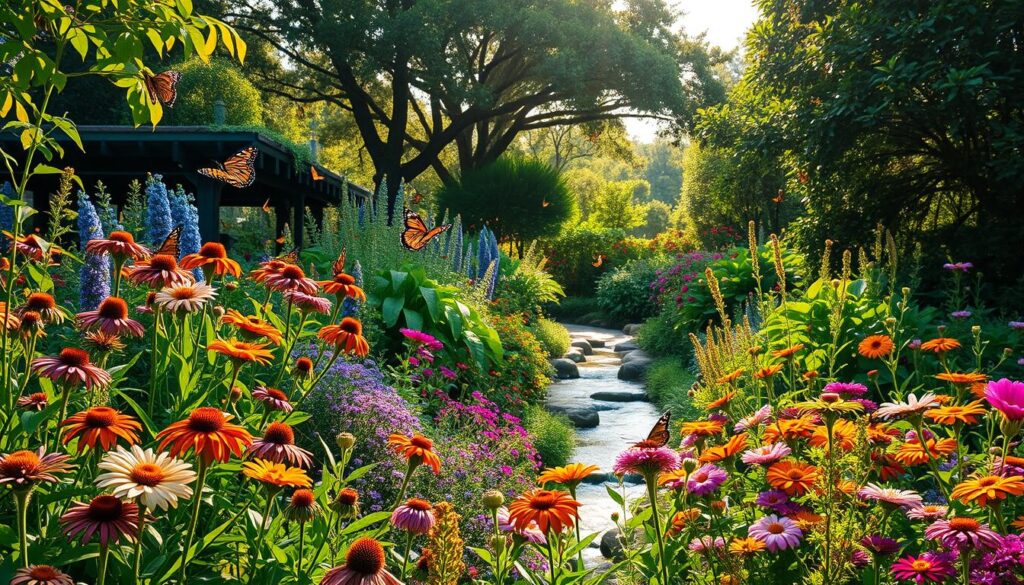
Incorporating Shelter and Shade
Butterflies need protection from wind, rain, and hot temperatures. Adding native trees, shrubs, and dense plants can offer them shelter. Also, having shaded areas helps protect them from the sun. These steps help support butterfly conservation efforts and make your garden more diverse and strong.
Adding native trees or shrubs to your garden is a good idea. It benefits butterflies and boosts your garden’s biodiversity.
Maintenance Tips for Your Butterfly Garden
Keeping your butterfly garden healthy is key. It needs organic care and attention all year round. This helps support the butterfly life cycle, from tiny caterpillars to flying adults.
Good maintenance keeps your garden healthy and full of life. It makes sure butterflies thrive and makes your garden look great.
Organic Gardening Practices
Organic gardening is essential for a butterfly garden. Stay away from harmful chemicals. Instead, use natural ways to fight pests and help plants grow strong.
Composting is a great way to make your soil better. It feeds your plants and helps them grow well. It also supports good bugs in the soil.
Seasonal Care Routines
Seasonal care is important for your garden. Each season has its own needs and challenges.
In spring and summer, keep your plants healthy. Prune, water, and make sure they get enough sun. In fall, clean up and protect plants from cold.
By following these tips and using organic gardening, you can have a vibrant butterfly garden. It will be a haven for local wildlife and a beautiful place for you to relax.
Using Pesticides Safely
Pesticides can help control pests but also harm butterflies. To make your garden butterfly-friendly, it’s key to know how these chemicals work. Look for safer ways to protect your garden.
Understanding Pesticide Impact
Pesticides can harm the ecosystem. They can kill butterflies directly or indirectly by poisoning plants. For example, broad-spectrum insecticides can wipe out local butterfly populations by destroying their food.
Integrated Pest Management (IPM) is a better way. It uses methods like introducing beneficial insects and crop rotation. This approach reduces the need for harmful chemicals.
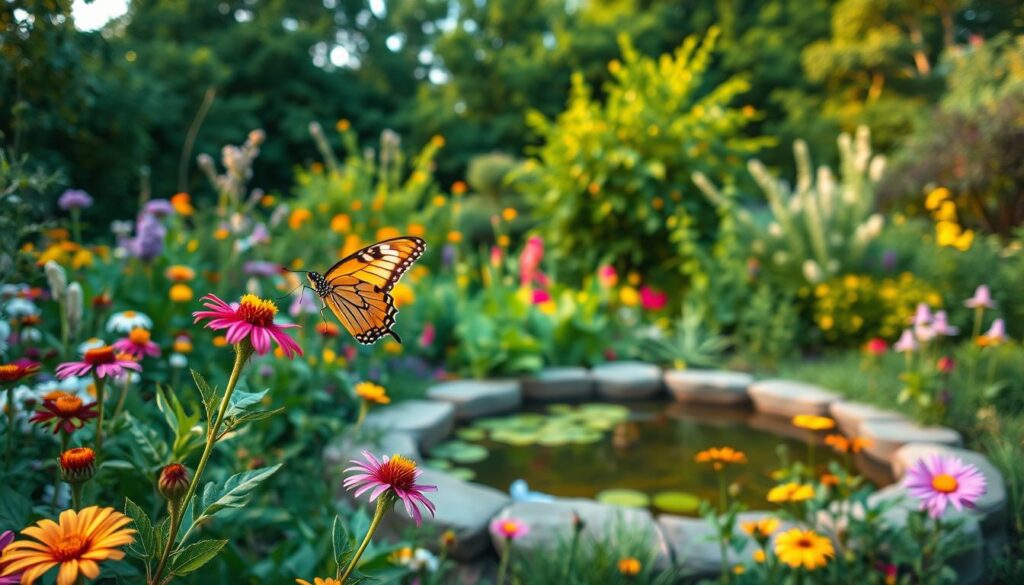
Safe Alternatives to Harmful Chemicals
There are safer options than harmful pesticides for your butterfly habitat. Organic pesticides like neem oil and pyrethrin are less harmful. They protect butterflies and other beneficial insects.
| Organic Pesticide | Source | Effectiveness |
|---|---|---|
| Neem Oil | Derived from the seeds of the neem tree | Effective against a wide range of pests |
| Pyrethrin | Derived from chrysanthemum flowers | Quick knockdown of insects |
| Diatomaceous Earth | Powder made from fossilized algae | Dehydrates and kills insects |
Using these safer options and IPM strategies can protect your garden. This way, you can make your garden a better place for butterflies.
Engaging the Community in Your Butterfly Project
Getting your community involved in your butterfly garden can make a big difference. It turns your garden into a safe space for these lovely creatures. By working together, you can help more butterflies in your area.
Hosting Butterfly Garden Workshops
Hosting workshops on butterfly gardening is a great way to get people involved. You can teach about native plants and how to make a butterfly-friendly garden. Sharing your knowledge helps others start their own gardens.
Encouraging Neighbors to Participate
Getting your neighbors to join in is key to a strong community. You can share flyers or invite them to garden with you. Together, you can make a network of butterfly-friendly gardens.
Also, involving kids in these activities is a wonderful way to teach them about conservation. It’s a fun way to learn about butterfly gardening. This effort can greatly improve your local environment.
Technology and Butterfly Monitoring
Technology has changed how we garden, including tracking butterflies. Gardeners can now use tools to learn about butterfly behavior and preferences. This helps them understand the butterflies in their gardens better.
Apps for Identifying Butterfly Species
Many apps help identify butterflies through photos and descriptions. These apps are great for gardeners who want to know which butterflies visit their gardens.
| App Name | Description | Platform |
|---|---|---|
| iNaturalist | A citizen science platform that allows users to identify and share observations of plants and animals. | iOS, Android |
| ButterflyNet | An app focused on butterfly identification and tracking. | iOS, Android |
| PictureThis | A plant and insect identification app that can also be used for butterflies. | iOS, Android |
Tracking Your Garden’s Butterfly Visitors
Tracking butterflies in your garden shows how well it supports them. By watching which species come and how many, you can make your garden better for butterflies.
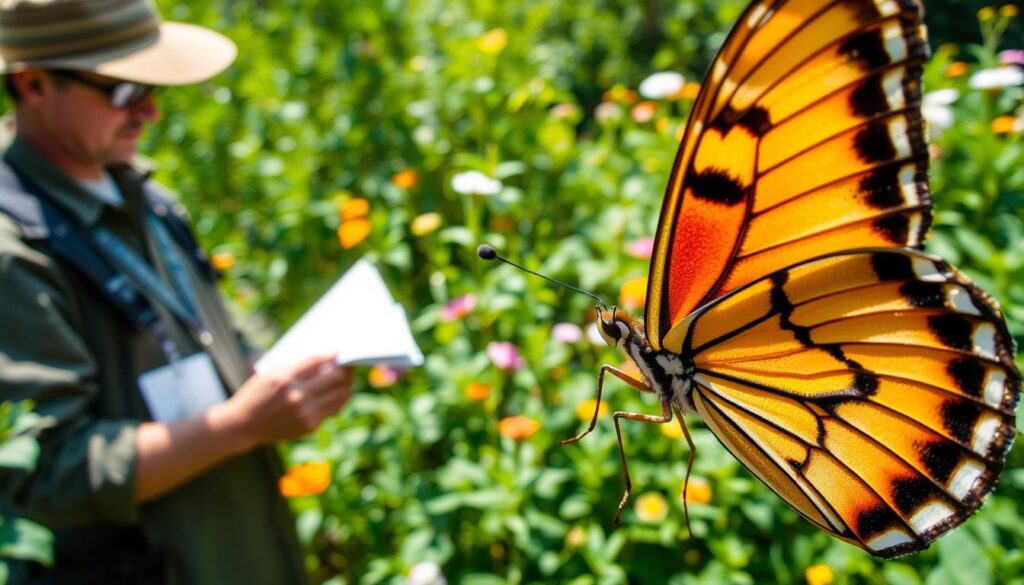
To track butterflies, keep a garden journal. Write down the species you see, how many, and any interesting behaviors. This helps you see patterns and improve your garden for butterfly populations.
Celebrating Butterflies in Your Garden
Creating a butterfly-friendly garden brings joy every day. Seeing these creatures up close is a treat. It’s a way to connect with nature and appreciate its beauty.
To enjoy these moments, it’s key to know how to observe them well. This makes your garden visits memorable.
Butterfly Observation Tips
Watching butterflies can be a fun hobby. Here are some tips to enhance your experience:
- Be patient and quiet to avoid scaring them away.
- Use a pair of binoculars for a closer look without disturbing them.
- Keep a journal to record the species you observe and their behaviors.
Creating a butterfly observation journal is both fun and educational. Write down the dates, times, and weather when you see different species. This helps you understand their patterns and preferences.
Hosting Butterfly-Themed Events
Sharing your love for butterflies with others is rewarding. Hosting events can educate and inspire your community.
Butterfly garden tours are a great way to show off your garden. You can also hold workshops on how to attract butterflies. This teaches others about the best gardening practices.
Here’s an example of a butterfly-themed event:
| Event Type | Description | Target Audience |
|---|---|---|
| Garden Tour | Guided tour of your butterfly garden, highlighting different species and plants. | Gardening enthusiasts, nature lovers |
| Workshop | Hands-on session on creating a butterfly-friendly garden. | Beginner gardeners, families |
| Observation Day | Join others in observing and recording butterfly species in your garden. | Nature enthusiasts, students |
By celebrating butterflies in your garden, you enhance your experience. You also help in their appreciation and conservation.
Educating Others About Butterflies
As you make your garden a haven for butterflies, think about teaching others too. By sharing what you know, you help protect these important creatures. This can inspire your community to help protect their habitats.
Community Outreach Programs
Organizing school or community programs is a great way to teach about butterflies. You can show them your garden, teach about gardening for butterflies, and talk about conservation. These activities help people understand and care for butterflies.
Sharing Your Experience
Using social media to share your garden journey can also help. Post pictures, share tips, and talk about your experiences. This can reach more people and encourage them to create their own butterfly-friendly gardens.
Leave a Reply